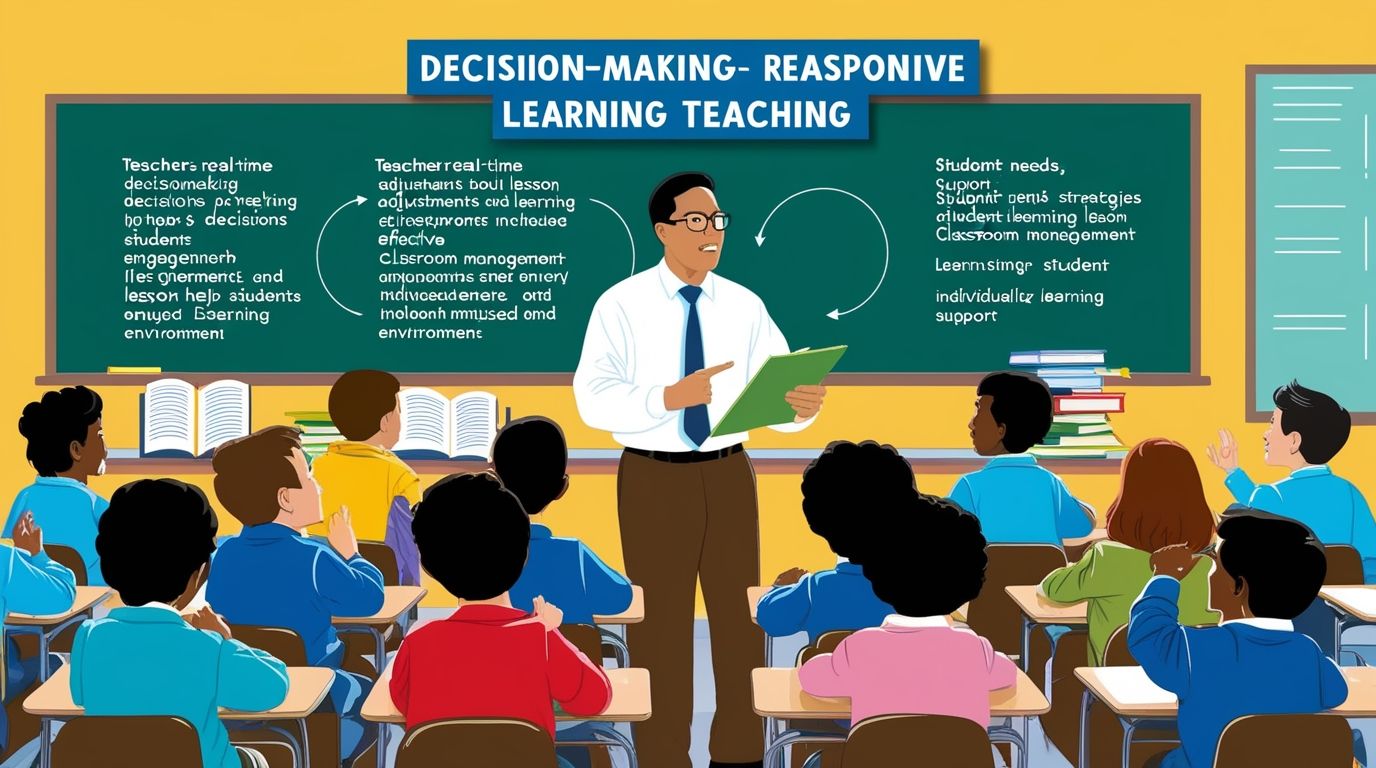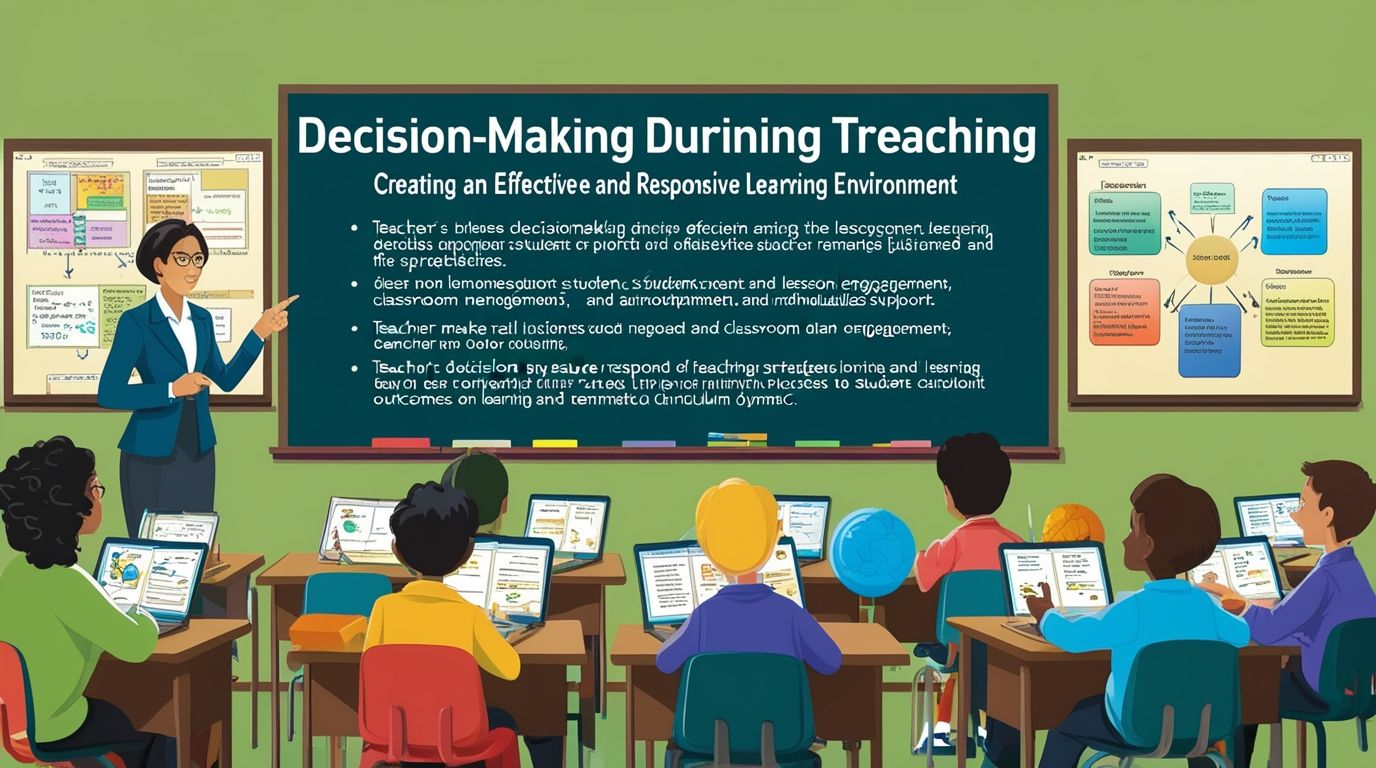Decision-Making During Classroom Teaching, Decision-making in classroom teaching is an essential skill that deeply impacts the learning environment and student success. Teachers constantly face numerous decisions, ranging from lesson planning to real-time classroom management and instructional delivery. The dynamic nature of the classroom requires educators to be agile and adaptive, ensuring that the learning process remains effective, inclusive, and engaging. This article will explore the nature of decision-making during classroom teaching, the types of decisions teachers must make, the factors that influence these decisions, and strategies for improving decision-making in the classroom.
The Nature of Decision-Making in Classroom Teaching
Teaching is a complex activity that involves continuous decision-making at multiple levels. These decisions can be classified into three categories: pre-active (before teaching), interactive (during teaching), and post-active (after teaching). Each type of decision has its own set of challenges and considerations, but all of them are interconnected, influencing one another.
- Pre-active Decisions: These are decisions made during the planning stage, where teachers determine the objectives, instructional methods, resources, and assessments to be used in the lesson. For instance, a teacher deciding which topics to prioritize based on the curriculum and student needs is an example of a pre-active decision.
- Interactive Decisions: Interactive decisions are those made in the moment while teaching. These decisions often require quick thinking and adaptation to the students’ reactions, engagement levels, and understanding of the material. For example, a teacher may need to decide on the fly whether to slow down a lesson, offer more examples, or change a teaching method based on student feedback.
- Post-active Decisions: These decisions occur after the lesson and involve reflection and evaluation. Teachers review the effectiveness of their teaching strategies and student learning outcomes to make adjustments for future instruction.
Each of these types of decisions requires careful consideration and is influenced by multiple factors, including the teacher’s experience, subject matter expertise, and awareness of student needs.
Types of Decisions Teachers Make in the Classroom
There are several key areas where decision-making plays a critical role in classroom teaching. These include instructional decisions, classroom management decisions, and student-related decisions.
- Instructional Decisions: Instructional decisions involve planning and delivering the curriculum to meet learning objectives. Teachers must decide on teaching strategies, pacing, and differentiation to accommodate diverse learners. For example, deciding whether to use direct instruction, inquiry-based learning, or cooperative learning depends on the subject matter and student learning styles. Teachers also make decisions about assessment methods, such as using formative or summative assessments to gauge student understanding.
- Classroom Management Decisions: Effective classroom management is crucial to maintaining an environment conducive to learning. Teachers must make decisions about rules, routines, and discipline strategies to ensure that students stay focused and respectful. These decisions include how to handle disruptions, allocate time for different activities, and create a classroom culture that promotes positive behavior. Balancing authority and flexibility is often a key challenge in classroom management decision-making.
- Student-Related Decisions: Teachers also make decisions that directly impact individual students, such as identifying when a student needs additional support, recognizing signs of disengagement, or determining when to offer praise or constructive feedback. Differentiating instruction to meet diverse learning needs and providing accommodations for students with learning disabilities are common examples of student-related decisions.

Factors Influencing Decision-Making in the Classroom
Several factors influence a teacher’s decision-making process in the classroom. Understanding these factors helps educators navigate complex situations and make informed choices.
- Teacher’s Knowledge and Experience: Experienced teachers are generally more adept at making quick and effective decisions because they have developed a repertoire of strategies and insights over time. Their ability to anticipate challenges and adapt to unexpected situations is often more refined compared to novice teachers. Additionally, a deep understanding of the subject matter gives teachers the confidence to adjust instructional methods and answer students’ questions effectively.
- Student Characteristics: The diversity of student backgrounds, abilities, and learning styles significantly influences decision-making. Teachers need to consider factors such as age, developmental stage, cultural background, and prior knowledge when planning lessons. In-class decisions, such as whether to slow down a lesson or offer additional support, are often based on the teacher’s assessment of student engagement and understanding.
More Factors:
- Classroom Environment: The physical and social environment of the classroom also plays a role in decision-making. Factors such as class size, available resources, and classroom layout can impact a teacher’s choices. For example, managing a large class may require different instructional and behavioral strategies than managing a smaller, more intimate setting. Teachers must also consider how the classroom atmosphere influences student behavior and learning.
- Curriculum and School Policies: The curriculum and school policies set the framework within which teachers operate. Teachers must align their decisions with the broader educational goals of the school and adhere to standardized curricula, which can sometimes limit their autonomy. However, within these boundaries, teachers can still make decisions about how to deliver content, engage students, and assess learning.
- External Pressures: Teachers are often influenced by external factors, such as standardized testing, administrative expectations, and parental involvement. These pressures can shape decision-making, particularly in relation to how time is allocated for instruction and assessment. For instance, the emphasis on test preparation may lead teachers to prioritize certain content areas over others, which may affect the overall depth and richness of the learning experience.
Strategies for Improving Decision-Making in the Classroom
Improving decision-making skills is essential for teachers to create a productive and adaptive learning environment. Several strategies can help teachers refine their decision-making processes:
- Reflective Practice: Reflective practice involves regularly analyzing one’s teaching methods and decisions to identify strengths and areas for improvement. By reflecting on their experiences, teachers can make more informed decisions in the future. This process can be enhanced by keeping a teaching journal, participating in peer discussions, or seeking feedback from students.
- Data-Driven Decision Making: Using data to inform instructional decisions is becoming increasingly common in education. Teachers can collect and analyze data from assessments, observations, and student feedback to make informed choices about lesson planning, differentiation, and classroom management. Data-driven decisions help ensure that teaching is responsive to student needs and that interventions are targeted and effective.
- Professional Development: Continuous learning is essential for improving decision-making skills. Professional development opportunities, such as workshops, courses, and mentoring programs, can expose teachers to new strategies, tools, and research-based practices. Teachers who stay current with educational trends and technologies are better equipped to make informed decisions in their classrooms.
- Collaborative Decision-Making: Collaboration with colleagues can enhance decision-making by allowing teachers to share insights, strategies, and experiences. Working in teams, such as grade-level or subject-specific groups, can provide diverse perspectives that lead to more thoughtful and well-rounded decisions. In addition, collaborative planning and problem-solving can help teachers feel more supported and confident in their choices.
- Mindfulness and Emotional Regulation: Teaching is emotionally demanding, and stress can impair decision-making. Practicing mindfulness and emotional regulation techniques can help teachers stay calm and focused during challenging situations, leading to more thoughtful and measured decisions. This is especially important for interactive decisions that require quick thinking, such as managing classroom disruptions or responding to student questions.
Conclusion
Decision-making is an integral part of classroom teaching that affects all aspects of instruction, classroom management, and student engagement. Teachers must make a wide range of decisions, from lesson planning to real-time adjustments based on student feedback. These decisions are influenced by multiple factors, including the teacher’s experience, student characteristics, and external pressures. By adopting reflective practices, using data, engaging in professional development, and collaborating with peers, teachers can enhance their decision-making skills and create a more effective and responsive learning environment.
In the ever-evolving educational landscape, the ability to make thoughtful, informed decisions is key to ensuring that all students receive a high-quality education tailored to their unique needs and abilities.

8 thoughts on “Decision-Making During Classroom Teaching”
Comments are closed.